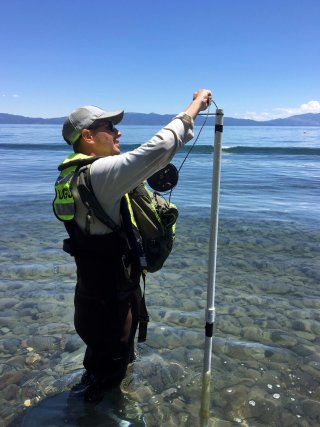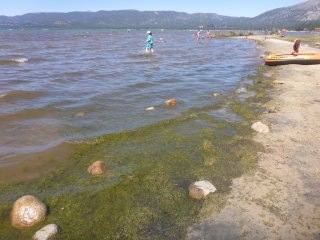Climate Change Connections: Nevada (Lake Tahoe)
Climate change is impacting all regions and sectors of the United States. The State and Regional Climate Change Connections resource highlights climate change connections to culturally, ecologically, or economically important features of each state and territory. The content on this page provides an illustrative example. As climate change will affect each state and territory in diverse ways, this resource only describes a small portion of these risks. For more comprehensive information about regional climate impacts, please visit the Fifth National Climate Assessment and Climate Change Impacts by Sector.
On this page:
Introduction: Lake Tahoe’s Iconic Blue Water
Lake Tahoe, which straddles the border between Nevada and California, is the largest alpine lake in North America, with 75 miles of shoreline and a maximum depth of over 1,600 feet.1 The lake is renowned for its crystal-clear blue water and striking scenery. The state of Nevada designated it as a “Waterbody of extraordinary ecological or aesthetic value.”2 The Lake Tahoe area is the ancestral home of the Washoe Tribe.3 The lake is considered the geographic and spiritual center of the Washoe world,3 and serves as an important center for fishing, hunting, and gathering for the Washoe people.
According to data from the U.S. Census Bureau, roughly 56,000 people live year-round in the Lake Tahoe area.4 Every year, millions of people visit Lake Tahoe to enjoy the scenery and participate in outdoor recreation in and around the lake. Tourism represents more than 60 percent of the region’s $5 billion economic output per year.5 Some activities popular on the lake include boating, swimming, kayaking, scuba diving, and fishing. The four Nevada state parks in the area cover diverse environments and are home to a rich spectrum of plants and wildlife.

Climate Impacts: Climate Change is Making Lake Tahoe Warmer
The Lake Tahoe region has been getting warmer, a trend that is expected to intensify with climate change. By 2100, average maximum air temperature is projected to increase by approximately 4°F to 9°F, making summers in Tahoe feel like summers in Carson City, Nevada do today.6 Warmer air temperatures also increase lake temperatures. Since records began in 1968, Tahoe’s lake surface temperature has been warming at a rate of 0.4°F per decade, and the top five warmest years on record have all occurred since 2009.1 By the end of the century, air and water temperatures could remain warm late enough into the season that water would be trapped at the surface for more than 60 days longer than in 1968, when temperature records were first consistently taken.7

Warmer surface water weakens the natural mixing processes critical to Lake Tahoe’s ecology and famed clarity.8 During the winter, surface water cools and sinks downward, bringing and dispersing particulates deeper into the lake, thereby improving water clarity.9 This mixing also cycles nutrients and oxygen critical to aquatic life throughout the lake. Hotter and longer summers keep warm water at the surface for longer periods of time, as it takes longer for the water to cool off, become denser, and sink.7 This reduction in water mixing can trap inflows of stream water and urban stormwater carrying fine sediment and nutrients at the surface of the lake, reducing water clarity.6 The trapping of warm, nutrient-rich water at the surface also promotes algal blooms that further degrade water clarity. The reduction in mixing can also affect aquatic life dependent on that exchange for oxygen and nutrients, such as the lake’s salmon population.
Climate change impacts, including wildfires and heavier rainfall events, can also affect lake clarity. In a region marked by fluctuations between intense drought and heavy rainfall, warming temperatures are leading to more extremes of both events.10 Heavy precipitation events are projected to become more intense, which could worsen flooding and runoff, discharging more sediment and organic matter into the lake.6 Warmer and drier conditions are also expected to fuel more wildfires in the region.10 Ash and particulate matter that collect in the lake from wildfires are expected to decrease water clarity and promote algae growth.6
Lake Tahoe is known for its beautiful blue color and crystal-clear water. Water clarity is measured by lowering a white and black disk, called a Secchi disk, into the water and recording the depth at which the disk can no longer be seen.11 The primary factor that affects this depth is the concentration of small particles in the lake, such as silt, clay, and algae.12 Water clarity in the lake has declined since the 1960s from around 100 feet visibility to around 60 feet today.13 While many factors contribute to the recent decrease in clarity, climate change is expected to further affect water quality through warming of the lake’s surface water.

The effects of reduced water quality go beyond diminishing aesthetic value. High water quality is critically important to the Washoe people, who consider water to be a sacred resource.14 Native biodiversity can also be threatened as lake conditions become more favorable to invasive species. For example, invasive warmwater bluegill and bass compete with and prey on native fish, and warming surface waters could allow these invasives to increase their numbers in the lake.15 Declining water quality can also increase the cost of treating drinking water supplies, reduce visitors’ enjoyment of the lake, and increase the risk of waterborne illnesses. Certain algal blooms release toxins into the water, which can make people and animals sick, though Lake Tahoe has not had these specific strains of algae to date. Blooms can also become more prevalent as lake water mixing patterns change as lake surface temperatures increase.8
Taking Action: Protecting the Lake in a Changing Climate
Addressing climate change requires reducing greenhouse gas emissions while preparing for and protecting against current and future climate impacts. Communities, public officials, and individuals in every part of the United States can continue to explore and implement climate adaptation and mitigation measures. Because warming temperatures are affecting water mixing in Lake Tahoe, local Tahoe organizations and residents are taking steps to control the amount of nutrients and sediment that enter the lake and taking steps to protect it, including:
- Research and planning. Lake Tahoe has a comprehensive Total Maximum Daily Loads (TMDL) plan, which sets a water clarity interim challenge goal of 78 feet by 2031 and a longer term TMDL target of nearly 100 feet by 2076.16 The region has already implemented projects for erosion control, stormwater system improvements, and river restoration. Efforts to restore the clarity in Lake Tahoe have reduced fine sediments, nitrogen, and phosphorus in the lake.16
- Enhancing vegetation cover and stormwater management. Research has found that more than 70 percent of the lake’s fine sediment pollution is from runoff from roads and other urban areas.16 Projects to reduce urban runoff, such as increasing vegetation cover, enhancing stormwater management, and decreasing erosion, can decrease the sediment and nutrient load entering the lake.8
To learn more about climate change impacts in Nevada and the Southwest region, see Chapter 28 of the Fifth National Climate Assessment.
Related Resources
- EPA Climate Change Indicators: Lake Temperature
- About Lake Tahoe (EPA)
- Lake Tahoe Water Quality Improvement Programs (EPA)
- Tahoe Climate Adaptation Primer (California Tahoe Conservancy) (pdf) (7.0 MB)
- Tahoe Regional Planning Agency
- Nevada State Climate Summary 2022 (NOAA)
References
1 UC Davis Tahoe Environmental Research Center. (2022). Tahoe: State of the lake report 2022. https://tahoe.ucdavis.edu/sites/g/files/dgvnsk4286/files/inline-files/2022_SOTL_complete-reduced_3.pdf
2 EPA. (2023). Lake Tahoe, California and Nevada: Stormwater runoff management in the Lake Tahoe basin (Watershed-Based Permitting Case Study). https://www.epa.gov/system/files/documents/2023-03/lake-tahoe.pdf
3 The Washoe Tribe of Nevada and California. (n.d.). Washoe history: A brief summary. Retrieved June 1, 2023, from https://washoetribe.us/aboutpage/4-Page-washoe-history
4 Tahoe Regional Planning Agency. (n.d.). Tahoe demographics. Tahoe Open Data. https://www.tahoeopendata.org/pages/demographics
5 Tahoe Prosperity Center. (2021). Baseline report for the Tahoe Basin: Living and working today in and around the Basin. https://tahoeprosperity.org/wp-content/uploads/TPC-Report_Sept-2021_Web.pdf
6 California Tahoe Conservancy. (2020). Integrated vulnerability assessment of climate change in the Lake Tahoe Basin. https://tahoe.ca.gov/wp-content/uploads/sites/257/2020/04/Integrated-Vulnerability-Assessment-of-Climate-Change-in-the-Lake-Tahoe-Basin_2020.pdf#page=13
7 Sahoo, G. B., Forrest, A. L., Schladow, S. G., Reuter, J. E., Coats, R., & Dettinger, M. (2016). Climate change impacts on lake thermal dynamics and ecosystem vulnerabilities. Limnology and Oceanography, 61(2), 496–507. https://doi.org/10.1002/lno.10228
8 California Tahoe Conservancy. (2021). Tahoe climate adaptation action portfolio 2021. https://tahoe.ca.gov/wp-content/uploads/sites/257/2021/08/tahoe-climate-adaptation-action-portfolio-2021.pdf
9 Coats, R., Perez-Losada, J., Schladow, G., Richards, R., & Goldman, C. (2006). The warming of Lake Tahoe. Climatic Change, 76(1–2), 121–148. https://doi.org/10.1007/s10584-005-9006-1
10 White, D. D., Elias, E. H., Thomas, K. A., Bradatan, C. E., Brunson, M. W., Chischilly, A. M., Enquist, C. A. F., Fisher, L. R., Froehlich, H. E., Koebele, E. A., Méndez, M., Ostoja, S. M., Steele, C., & Vanos, J. K. (2023). Ch. 28. Southwest. In A. R. Crimmins, C. W. Avery, D. R. Easterling, K. E. Kunkel, B. C. Stewart, & T. K. Maycock (Eds.), Fifth National Climate Assessment. U.S. Global Change Research Program. https://doi.org/10.7930/NCA5.2023.CH28
11 EPA. (n.d.). Introduction to the watershed planning process. Watershed Academy Web. Retrieved December 16, 2023, from https://cfpub.epa.gov/watertrain/moduleFrame.cfm?parent_object_id=905&object_id=909
12 Tahoe Environmental Research Center. (2023). Lake Tahoe’s clarify the best it’s been since 1980s: The return of native zooplankton aided Tahoe clarity efforts in 2022. University of California, Davis. Retrieved December 16, 2023, from https://tahoe.ucdavis.edu/secchi
13 Naranjo, R., Work, P., Heyvaert, A., Schladow, G., Cortes, A., Watanabe, S., Tanaka, L., & Elci, S. (2022). Seasonal and long-term clarity trend assessment of Lake Tahoe, California–Nevada (Scientific Investigations Report No. 2022–5070). U.S. Geological Survey. https://pubs.usgs.gov/sir/2022/5070/sir20225070.pdf
14 The Washoe Tribe of Nevada and California. (2021). Wa She Shu: “The Washoe People” past and present. https://washoetribe.us/articleblogpage/735-Page-washoe-tribe-history-past-and-present
15 California Tahoe Conservancy. (2021). Tahoe climate adaptation primer. https://tahoe.ca.gov/wp-content/uploads/sites/257/2021/06/Tahoe-Climate-Adaptation-Primer.pdf
16 California Water Boards & Nevada Division of Environmental Protection. (2022). Lake Tahoe TMDL Program 2022 performance report: 10-year review: A decade of meaningful progress. https://clarity.laketahoeinfo.org/FileResource/DisplayResourceAsEmbeddedPDF/368ea518-4a49-4d65-83c2-41c42a0eea77

